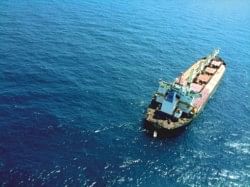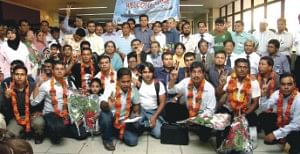Special Feature
In the Grasp of Pirates
Shamim Ashraf
He lies in his cabin, relaxed, getting prepared for the night. The soft breeze plays with the blue water, creating small waves in the calm Indian Ocean. The water ripples as if in delight at the soft embrace of the afternoon ray. What a bright day, Farid thinks resting his chin against his right palm.
“Could you please come up? Something seems to be heading towards us,” somebody rings up. Jumping up, he rushes out of the fifth-floor cabin to the bridge room a floor above.
***
 |
MV Jahan Moni photographed from a plane a day before its release.
Photo: courtesy |
Nearly two hours later.
“You've heard about Somali Pirates?”
“Yes.”
“We're the Somali Pirates.”
Marry Noor, the second-in-command of the Pirates group, shouts in broken English while two of his associates point AK-47 rifles at Farid Ahmed, who had been at the helm of MV Jahan Moni since July 13, 2010.
Brandishing his assault rifle, Noor advices the skipper and his men to be calm and quiet, saying they would not harm any of them. “But if you try to be smart, we'll kill you straight away.”
As if, a black curtain suddenly falls, silencing the mighty ocean. Or deafening the sailors against the unbearable words of the pirates?
***
When the Bangladesh-flagged ship sails from Tanjung Buli port of Indonesia on November 11 with 43,150 tonnes of nickel ore on its way to Greece, little does its crew know what is in store for them. It stops at a Singapore port for some minor repair and sails out on November 27 for Port of Thessaloniki in Greece.
Already aware about the pirates' activities, the sailors are on the watch as the ship races at a speed of 11.5 nautical miles as they enter the pirates-infested territory. The crew are a little unhappy that current and wind slows down their vessel a little.
The watch-keeper first notices the skiff when they reach near Minicoy Island, 100 nautical miles off Sri Lankan coast. It is 3:00pm local time on December 5, 2010. Alarmed by the information, the curious sailors are crammed in the small bridge room on the top floor of the six-storied ship.
Hearts sink: a skiff is travelling fast towards MV Jahan Moni.
As briefed beforehand, the sailors put six dummies of sailors on the starboard and bow as they also gather there with fire axe, iron rods and whatever they could find. They, at the same time, blow whistles.
Farid, who has already taken over the wheel, starts zigzag manoeuvring (coursing the ship on a zigzag path) to keep off the pirates' skiff. He has trouble doing it in the calm sea.
At the same time, the skipper informs MV Jahan's operator in Chittagong and UK Maritime Trade Operations (UKMTO) about the pirates' approach.
Closing in within minutes, the grim faced black figures try to hook up with the ship with a long ladder.
"Hurrah!" There is celebration in the bridge: the pirates' skiff has some trouble and falls behind.
“While in the sea, we completed an anti-piracy drill in the Indian Ocean on December 2 and the crew know what to do when there is any attack,” Captain Farid Ahmed tells The Daily Star.
 |
Relatives throng Shah Amanat International Airport to welcome the freed Bangladeshis. Photo: Anurup Kanti Das |
Fearing that the pirates may try again, the captain does not slacken the speed. All hopes shatter in nearly 45 minutes when the pirate skiff reappears on the horizon and travels at a speed not less than about 22 nautical miles. As they close in, suddenly the pirates start shooting with their AK-47s in the air. There is no point trying to resist, the skipper thinks. “Everybody get to the bridge. Now. Now. Now,” he says in a hurry.
All the 25 crew and the wife of the chief engineer go up there. They lock all ducts and portholes quickly to put up a feeble resistance, knowing well that it cannot protect them from the heavily armed pirates.The pirates' skiff touches down their ship. Hooking up their ladder to the railing, the pirates climb up to the bridge room in a few minutes. As they wait for the inevitable, the sailors hear the impatient sound the gun barrels on the windowpanes. “Open the door. Otherwise we will fire!”
As one sailor opens the door, the pirates storm in.
“Everybody on the floor. Quick, quick!” Flows order. The crew members oblige.
Three of the sailors faint.
Three of the pirates come in led by Marry Noor, while three watch guard outside. They seize all the mobile phones and laptops so that the sailors cannot communicate with anyone outside. One pirate fires a gunshot to invite a fishing boat, which they are using as the mother vessel, waiting nearby. Six more join the captors on MV Jahan.
Estimating their fall, the skipper sends SAS message to Brave Royal Ship Management (BD) Limited, its operating company, and Director General of Shipping and in Bangladesh besides sending SOS signal. “Noor had a GPS (Global Positioning System) with him. He showed a point on it and asked me to alter our course to Somalia,” Farid recalls.
As they sail off, the pirates tell the hostage that they have followed MV Jahan Moni over the last two days. And the mother vessel they are using is also a hijacked one, previously used by Sri Lankan fishermen.
Two and a half hours later, an Indian naval ship appears in the scene. “Jahan Moni, Jahan Moni, Indian Navy calling,” somebody calls on the VHF radio.
The metallic message creates panic among the pirates.
“Come on the VHF and communicate with them. Tell them to go back,” Abdur Rashid, pirates' commander, screams at Farid.
Knowing very well that the navy has nothing to do now, he passes the instruction.
But the Indian ship remains there. This angers the pirates, who give the captain 10 minutes to send back the ship.The Indian ship asks for number of the pirates, where are they positioned and what firearms they are carrying.
Rashid shouts at Farid, “I'm giving you three minutes to send back the ship. Otherwise we'll kill you all.”
With the safety of the crew in mind there is no other alternative except complying. The captain says: “Please move away from us. They are 12 in number and in control of the ship. They are pointing guns at us and can fire anytime. If you try to rescue us, they'll kill us.”
The Indian ship comes at 7:30pm the following day and on the third day.
“The Indian navy wanted to blow away the fishing boat. But I asked them not to do anything because that could put our lives in danger,” the skipper says.
While each of the pirates has an AK-47 rifle, commander
Rashid has a grenade. They also have a rocket-propelled grenade.
The sailors sink in despair with the Indian ship disappearing slowly into the vast sea.
Five days later, MV Jahan Moni anchors at Garacad, a settlement slightly below Puntland. Nine other hijacked ships can also be seen there. Uncertain what the coming days are bringing for them, Jahan Moni's crew members sink in despair. At 11:00pm, an hour into their anchoring there, a heavy gunfight begins. Some skiffs and fishing boats fire at MV Jahan, prompting the pirates to reply. The fight continues till 3:00am.
The sailors later learn that their captors' rival groups have tried to take control of the ship. The next day, the pirates shift to another place 20-25 nautical miles away.
The skipper does not let anyone know that the Automatic Identification System (AIS) is on and is sending signal on its location. The worrying relatives and ship owners in Bangladesh receive the much-expected phone call at around 2:30pm (Bangladesh time) on December 12.
“I am captain speaking. We're in Somalia, captured by pirates. We are safe and sound,” Farid tells Meherul Karim, general manager of Brave Royal Ship. Meherul assures them of all necessary steps to free them and asks them to have patience.
Later in the night, the pirates demand $9 million for their release. They also let some crew members convey the information to the owner.
The captain is cautious, watching his men and trying to keep their morale high. Convening a meeting, he tells everyone to say prayers in jamaat and to recite the Quran.
The ship's water tanks go empty within 15 days of capture. Rationing does not help much. The pirates start bringing in mineral water once a week. To survive, the sailors put the vent pipe of the air coolers into a small drum and collect the condensed water. As fuel also runs low, they shut down a generator and the freezer. This causes the food to go off, forcing them to throw those in the sea.
Then begins a severe food rationing. The pirates start to serve ruti, sugar and sometimes dates. They sometimes bring in lambs and ask the crew to slaughter those. Moshiur Rahman, the chief cook, has to cook curry for them too. After the pirates have their meals, the leftover is served to the crew.
The pirates allow the sailors to catch fish. “Surprisingly, the pirates did not take fish,” a sailor says. As the lentil is running out, the sailors started cooking biriyani in the night for dinner and breakfast.
Herded in the tiny bridge room, the 26 hostages have to use the lone washroom.
The lights, powered by emergency generator, go out at 9:30pm.
Annoyed by pirates' activities, the local government in Garacad asks them to remove the ship immediately, saying they would shoot at them otherwise.
On January 24, the pirates shift to Hobyo, a harbour city 120 nautical miles down south. Six days later, MV Jahan Moni has to leave the place for similar threat to another place 10 nautical miles north.
On February 25, the ship is taken to a place named Dhinowada near Garacad.
While changing location, MV Jahan was unable to speed up due to growth of plankton and snails at the bottom of the ship. Annoyed at the slow pace, the pirates threaten to kill the chief engineer.
“One of them asked him to say his prayers, saying they would kill him in a couple of hours,” says Shahriar Rabbi, an engine cadet who has been hijacked on his maiden voyage.
Explaining the situation, the captain convinces him not to
kill the chief engineer.
As weeks of despair and terror pass, the pirates keep watchful guards and suspect each of the sailors' move.
Abdur Rashid, the gang leader, barges into the bridge one morning intoxicated. Raising his firearms suddenly, he aims it at Ruhul Amin, the anchorman.
Another pirate appears just then and takes away the gun from him. This is when Rashid loses his command on his gang and Marry Noor takes over.
Over the 100 days of their captivity, the sailors try to play obedient slaves, complying with orders whether it is preparing coffee, fetching water or cooking food.
 |
Main Uddin is all smiles as he comes out of the airport with his first born. Photo: Anurup Kanti Das |
Seeing a long queue at the place fixed for ablutions (wazu), crew member Nazimuddin once performs ablutions elsewhere. Angered at this, the pirates tie his hands and legs behind his back and forces him to lie down. The pirates force second engineer Mohammad Main Uddin to pee in a bottle seeing him working on a computer without their permission. The pirates tell stories on what they have done in other ships to “discipline” the hostages.
Saying that three to four hostages get killed in each hijacked ship, the pirates describe how they have killed one on an Egyptian ship for hiding fuel. To force them to pay the ransom, the pirates tell them that they would be “forced” to kill the sailors if the owners do not pay the ransom quickly.
The pirates caution the hostages against cheating. “Don't try to cheat us. You know, cost of a life is one dollar only,” the pirates' commander says, meaning that it takes a bullet to kill one and the bullet costs a dollar.
After their capture, the captain decides not to project the ship owner as a rich man or having more than one ship. He tells the pirates that the owner would not be able to meet their demand if it is high.
Once putting their demand at $9m, the pirates keep on the negotiation with Meherul Karim.
As a small aeroplane comes, the crew know the negotiation is on and at the final stage. They have rightly guessed that the plane has come to take photographs to furnish the owners as proof that the hostages are still alive.
The next day, the Cessna comes again. What could be a more pleasing and peaceful noise!
As the aeroplane hovers over the ship, its door opens suddenly to let two boxes fall. The pirates scoop them on their skiff. The pirates sit in groups on the ship deck and check each bundle: exactly $4.72 million -- $ 4.62 million as ransom and $ 100,000 for fuel to bring the ship home. This is what they have demanded.
 |
The freed sailors pose for the camera at Shah Amanat International Airport.
Photo: Anurup Kanti Das |
All smiles, the pirates' leader meets Farid and announces: “We will be leaving the ship tomorrow morning. You'll also sail out.”
Mohammed Shahjahan, managing director of SR Shipping, owner of MV Jahan Moni, denies paying the pirates any ransom. “We haven't paid them [Somali pirates] anything, but I don't know whether our insurance company did,” he says.
The thought that they are going to get a huge ransom has made some pirates give away Somali shilling to the hostages as souvenirs.
Why won't they when the business is so lucrative?
Pirates took 1,181 people hostage off the Somali coast last year. Almost half of them were released on payment of ransoms while a few died of abuse or neglect. The International Maritime Bureau (IMB), a branch of the International Chamber of Commerce, in January alone recorded 35 attacks in which pirates hijacked seven ships and took 148 people hostage. It says out of the 15 incidents of hijacking worldwide, 14 of them took place near Somalia, till March 16. Seven hostages were killed during that period.
The problem has worsened in recent years. According to The Economist, there were 219 attacks last year compared with 35 in 2005. Ransoms paid last year climbed to $238 million, an average of $5.4 million a ship, compared with $150,000 in 2005.
The United Nations estimates the annual cost of piracy in the Indian Ocean at between $5 and $7 billion.
For the 26 hostages on Jahan Moni, March 13 seems to be the longest night they had ever spent. They are actually going home! They can't sleep the whole night thinking about the new day.
With the sun removing the darkness, the pirates' leader meets the skipper, asking him to lift the anchor. There is silence in the bridge. As Marry Noor goes out, the hostages suddenly start hugging one other.
Some are afraid that other groups may attack them.
To assure him, the pirates furnish a handwritten letter that says in English and Somali language that they have already paid ransom. “If any group board the ship, show it to them. They'll get down immediately,” the pirate leader says.
Ruhul Amin, the man in charge of the anchor, lifts the anchor. Here in Bangladesh, it is 9:57am, March 14.
The ship struggles to embark at full speed to sail out of the pirates' territory as quickly as possible.
Freed, MV Jahan berths safely at Port of Salalah in Oman in five days. Officials of Brave Royal and SR Shipping, the ship owner, have already flown there to welcome the crew members.
Shaila Naz Ahmed, wife of Farid Ahmed, has also flown there to meet her husband.
A new 26-member crew led by Master Mushtaq Al-Mahmood takes over as the ship prepares to sail towards Greece where it was heading with 43,150 tonnes of nickel at the time of the hijack. On completion of medical checkups and immigration formalities, the crew go to Hamdan Plaza Hotel and Hilton Hotel in Salalah city.
For the staff of Shah Amanat Airport in Chittagong, March 21 dawns with a bright smile. They clean the VIP lounge with utmost care because they know some brave sailors are returning home after a 100-day of nerve-wrecking captivity.
As they wait for the touchdown of an Oman Airways flight carrying the sailors, their relatives impatiently stare through the glass wall at the runway. At 3:25pm, the flight lands.
Tears and smiles, joy and relief engulf all who throng there to welcome the sailors.
Rabbi's mother Bilkis Rahman proudly says she has arranged a feast for all her neighbours and relatives on the occasion.
Main Uddin gets the most beautiful gift upon landing in Chittagong: his first child who was born while his father was held hostage. With his hands stretched wide, he runs and picks the baby up from his wife's lap.
He holds the child high and doesn't know how to hold back his tears.
-The writer is Web Editor (content) of The Daily Star.
|
